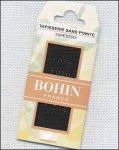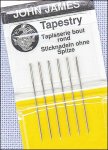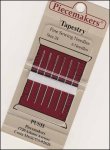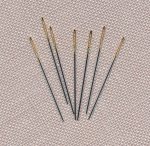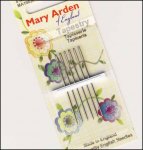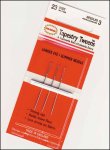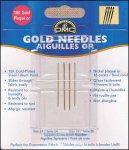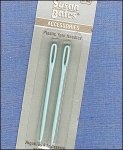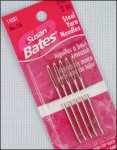Welcome to MyStitchWorld.com. Cross Stitch Distributors
Cross stitch Needle (Size) Guide. Part 2
Needle guide. Needle size guide
NEEDLES SAMPLES. YARNTREE.
Source:
http://yarntree.com/cross-stitch/index.php?main_page=index&cPath=200
Where to buy Needles:
http://www.123stitch.com/Needles.html
https://www.lovecrafts.com/en-gb/search?q=needles
http://www.abcstitch.com/kits_php/needles.php
Source: https://www.thehappycross-stitcher.com/page.php?xPage=needles.html
|
Types of Needle There are many different kinds of needle available for all manner of sewing, here are some of the most popular. Tapestry Needles Embroidery Needles Sharps Beading Needles Quilting Needles Darning Needles Chenille Needles Plastic Needles Which size needle to use with aida fabric? 6 count – size 18 Which size needle to use with evenweave and linen fabric? 22 count – size 22 Hints and Tips
Embroidery needles come in many different types and picking the ideal one can make your needlework more enjoyable. But how do you know which one you should be using? The basic rule is to pick the finest needle that will accommodate the thread and fabric that you wish to use. One that is too large will create holes in the fabric that the thread does not fill in, one that is too fine will mean that the thread gets rubbed unnecessarily every time the needle goes through the fabric, meaning that it will fray quickly.
Needles are usually sized with the larger numbers being reserved for the thinner needles, a fact which confuses many people. As an example a size 24 tapestry needle (ideal for working on 14 count Aida cloth) is thicker than a size 26, which is used for 28 or 32 count evenweave fabrics. The thicker size 18 would be best suited for canvas work. The Point If you are working on a closely woven fabric, then you need to use a pointed needle. For evenweave fabrics, such as Aida cloth, linen or canvas, you would use a blunt or tapestry needle to prevent you splitting the fabric threads. There are even ball-pointed needles for use on knitted fabrics like jersey or sweatshirt material. The width The length The eye
Here are five points that are helpful to know about hand embroidery needles: Needles for counted work 1. Types: Different embroidery needles do different jobs. There are several commonly used embroidery needles. Embroidery (or “crewel”) needles have sharp points and slightly elongated eyes. They’re used for crewel work and most surface embroidery where piercing through the fabric threads is necessary to the stitching. Tapestry needles (pictured above) have long eyes and blunt points. They’re used for counted work, drawn thread work, canvas work, or other types of needlework in which the point of the needle is not meant to pierce the fabric threads. Chenille needles have a long eye like the eye on tapestry needles, but a sharp point, and can be used effectively in crewel work and other wool embroidery, or any surface work where a longer eye and a sharp point is desired. Straw or milliner needles have an eye and shaft that are equal in thickness, which makes them ideal for French knots and bullion knots, or any stitch where the needle must pass through multiple wraps of thread. Hand Embroidery Needles 2. Size: The higher the number, the smaller the needle. This is true within types of needles. Embroidery needles are commonly numbered 1 – 12, and size 12 is significantly smaller than size 1! Tapestry needles and chenille needles are numbered commonly from 18 – 28, with 28 being the smallest. Threaded Embroidery Needle 3. Relativity:: The choice of needle size is relative to the type and size of thread. For example, crewel yarn will require a much larger needle than fine silk will, because crewel yarn is a lot thicker than silk. The needle should be the right size to allow the thread to pass through the fabric with minimal abrasion, but not so large that the needle leaves a noticeable hole around the thread. Japanese hand-made needle 4. The Eye: On machine-made needles, the eye is larger on one side than it is on the other, because of the manner in which the hole is punched or bored by the machine that makes it. If you have trouble threading your needle from one side of the eye, turn the needle around. It might help! There is also a “ridge” on the inside of the eye of machine-made needles. On hand-made needles (like the one in the image above), the eye is perfectly smooth and round, making these needles ideal for metal threads (and other similar threads), as the thread will not wear as readily as it will in a machine-made needle. Needles in Emery 5. Threading: Did you know you aren’t supposed to lick your thread when you thread your needle? The primary reason for this is that the wet thread can cause the inside of the eye to rust, which can quickly fray your embroidery threads while stitching. To polish up your needles (including the eye), run them through a strawberry (or other shape) filled with fine emery sand. This will help remove rust that may have formed in the eye of the needle. |
